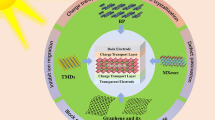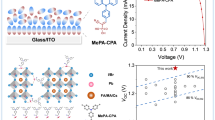Abstract
This study describes the fabrication of p-Cu2O/n-MZO/FTO heterojunctions by using a simple two-step electrodeposition method. Electronic, microstructural, morphological, optical, and electrical properties have been systematically investigated by using a variety of analysis techniques. Mott–Schottky analysis indicated p-type conductivity for Cu2O and n-type conductivity for ZnO. Analysis revealed the decrease of the conduction band offset at the Cu2O/MZO interface with the contribution of Mg doping approach, which accounts for the upward movement of the conduction band edges of MZO layers. X-ray diffraction indicated that Cu2O and ZnO films were polycrystalline in nature with strong cubic Cu2O(111) and wurtzite ZnO(002)-oriented phases. Morphological analyses revealed that Mg doping could produce finer microstructures and improve the surface flatness of films. The optical measurement indicated that Mg doping enable the band gap engineering of ZnO films and the design of high-performance photovoltaic window layers. Current–voltage plots showed that Au/p-Cu2O/n-ZnO(MZO)/FTO heterojunctions exhibited an excellent rectifying behavior and their electrical performance can be effectively controlled by using Mg doping approach.








Similar content being viewed by others
References
C. Breyer, D. Bogdanov, A. Aghahosseini, A. Gulagi, M. Child, A.S. Oyewo, J. Farfan, K. Sadovskaia, P. Vainikka, Solar photovoltaics demand for the global energy transition in the power sector. Prog. Photovolt. Res. Appl. 26(8), 505–523 (2017)
F. Chigondo, From metallurgical-grade to solar-grade silicon: an overview. Silicon 10(3), 789–798 (2017)
R. Vittal, K.-C. Ho, Zinc oxide based dye-sensitized solar cells: a review. Renew. Sustain. Energy Rev. 70, 920–935 (2017)
M.A. Green, Thin-film solar cells: review of materials, technologies and commercial status. J. Mater. Sci. Mater. Electron. 18(S1), 15–19 (2007)
S. Rühle, A.Y. Anderson, H.-N. Barad, B. Kupfer, Y. Bouhadana, E. Rosh-Hodesh, A. Zaban, All-oxide photovoltaics. J. Phys. Chem. Lett. 3(24), 3755–3764 (2012)
A. Pérez-Tomás, A. Mingorance, D. Tanenbaum, M. Lira-Cantú, Metal oxides in photovoltaics: all-oxide, ferroic, and perovskite solar cells, in The Future of Semiconductor Oxides in Next-Generation Solar Cells. (Elsevier, 2018), pp.267–356
S. Sun, X. Zhang, Q. Yang, S. Liang, X. Zhang, Z. Yang, Cuprous oxide (Cu2O) crystals with tailored architectures: a comprehensive review on synthesis, fundamental properties, functional modifications and applications. Prog. Mater Sci. 96, 111–173 (2018)
S. Rühle, Tabulated values of the Shockley–Queisser limit for single junction solar cells. Sol. Energy 130, 139–147 (2016)
N.G. Elfadill, M.R. Hashim, K.M. Chahrour, S.A. Mohammed, Electrochemical deposition of Na-doped p-type Cu2O film on n-type Si for photovoltaic application. J. Electroanal. Chem. 767, 7–12 (2016)
A. Janotti, C.G. Van de Walle, Fundamentals of zinc oxide as a semiconductor. Rep. Prog. Phys. 72(12), 126501 (2009)
T. Minami, Y. Nishi, T. Miyata, Efficiency enhancement using a Zn1−xGexO thin film as an n-type window layer in Cu2O-based heterojunction solar cells. Appl. Phys. Express 9(5), 052301 (2016)
Y.S. Lee, D. Chua, R.E. Brandt, S.C. Siah, J.V. Li, J.P. Mailoa, S.W. Lee, R.G. Gordon, T. Buonassisi, Atomic layer deposited gallium oxide buffer layer enables 1.2 V open-circuit voltage in cuprous oxide solar cells. Adv. Mater. 26(27), 4704–4710 (2014)
T. Minami, T. Miyata, K. Ihara, Y. Minamino, S. Tsukada, Effect of ZnO film deposition methods on the photovoltaic properties of ZnO–Cu2O heterojunction devices. Thin Solid Films 494(1–2), 47–52 (2006)
X. Chen, P. Lin, X. Yan, Z. Bai, H. Yuan, Y. Shen, Y. Liu, G. Zhang, Z. Zhang, Y. Zhang, Three-dimensional ordered ZnO/Cu2O nanoheterojunctions for efficient metal-oxide solar cells. ACS Appl. Mater. Interfaces 7(5), 3216–3223 (2015)
B. Kramm, A. Laufer, D. Reppin, A. Kronenberger, P. Hering, A. Polity, B.K. Meyer, The band alignment of Cu2O/ZnO and Cu2O/GaN heterostructures. Appl. Phys. Lett. 100(9), 094102 (2012)
A.S. Zoolfakar, R.A. Rani, A.J. Morfa, S. Balendhran, A.P. O’Mullane, S. Zhuiykov, K. Kalantar-zadeh, Enhancing the current density of electrodeposited ZnO–Cu2O solar cells by engineering their heterointerfaces. J. Mater. Chem. 22(40), 21767 (2012)
D.C. Olson, S.E. Shaheen, M.S. White, W.J. Mitchell, M.F.A.M. van Hest, R.T. Collins, D.S. Ginley, Band-offset engineering for enhanced open-circuit voltage in polymer–oxide hybrid solar cells. Adv. Func. Mater. 17(2), 264–269 (2007)
J. Kaur, O. Bethge, R.A. Wibowo, N. Bansal, M. Bauch, R. Hamid, E. Bertagnolli, T. Dimopoulos, All-oxide solar cells based on electrodeposited Cu2O absorber and atomic layer deposited ZnMgO on precious-metal-free electrode. Sol. Energy Mater. Sol. Cells 161, 449–459 (2017)
Y. Ievskaya, R.L.Z. Hoye, A. Sadhanala, K.P. Musselman, J.L. MacManus-Driscoll, Fabrication of ZnO/Cu2O heterojunctions in atmospheric conditions: Improved interface quality and solar cell performance. Sol. Energy Mater. Sol. Cells 135, 43–48 (2015)
T. Minami, Y. Nishi, T. Miyata, S. Abe, Photovoltaic properties in Al-doped ZnO/non-doped Zn1−xMgxO/Cu2O heterojunction solar cells. ECS Trans. 50(51), 59–68 (2013)
H.S. Sajjadizadeh, E.K. Goharshadi, H. Ahmadzadeh, Photoelectrochemical water splitting by engineered multilayer TiO2/GQDs photoanode with cascade charge transfer structure. Int. J. Hydrog. Energy 45, 123–134 (2020)
H.S. Sajjadizadeh, H. Ahmadzadeh, E.K. Goharshadi, M. Aziznezhad, Engineering of a high-efficiency water splitting photoanode by synergistic effects of doping, compositing, and coupling on TiO2 nanoparticles. Electrochim. Acta 362, 137149 (2020)
Z. Zhang, P.J. Wang, Highly stable copper oxide composite as an effective photocathode for water splitting via a facile electrochemical synthesis strategy. Mater. Chem. 22(6), 2456–2464 (2012)
H.-Y. Liu, H. Kong, X.-M. Ma, W.-Z. Shi, Microstructure and electrical properties of ZnO-based varistors prepared by high-energy ball milling. J. Mater. Sci. 42(8), 2637–2642 (2007)
D. Kang, D. Lee, K.-S. Choi, Electrochemical synthesis of highly oriented, transparent, and pinhole-free ZnO and Al-doped ZnO films and their use in heterojunction solar cells. Langmuir 32(41), 10459–10466 (2016)
A.C. Aragonès, A. Palacios-Padrós, F. Caballero-Briones, F. Sanz, Study and improvement of aluminium doped ZnO thin films: limits and advantages. Electrochim. Acta 109, 117–124 (2013)
F.K. Shan, G.X. Liu, W.J. Lee, B.C. Shin, Stokes shift, blue shift and red shift of ZnO-based thin films deposited by pulsed-laser deposition. J. Cryst. Growth 291(2), 328–333 (2006)
Z.J. Othman, A. Matoussi, F. Fabbri, F. Rossi, G. Salviati, Optical and structural properties of Zn1−xMgxO ceramic materials. Appl. Phys. A 116(3), 1501–1509 (2014)
C.M. McShane, K.-S. Choi, Junction studies on electrochemically fabricated p–n Cu2O homojunction solar cells for efficiency enhancement. Phys. Chem. Chem. Phys. 14(17), 6112 (2012)
Y. Xu, M.A.A. Schoonen, The absolute energy positions of conduction and valence bands of selected semiconducting minerals. Am. Miner. 85(3–4), 543–556 (2000)
Z. Duan, A. Du Pasquier, Y. Lu, Y. Xu, E. Garfunkel, Effects of Mg composition on open circuit voltage of Cu2O–MgxZn1−xO heterojunction solar cells. Sol. Energy Mater. Sol. Cells 96, 292–297 (2012)
C. Yu, X. Zhang, Synthesis of a Cu2O/carbon film/NiCoB-graphene oxide heterostructure as photocathode for photoelectrochemical water splitting. ChemElectroChem 6, 2004–2012 (2019)
L.I. Bendavid, E.A. Carter, First-principles predictions of the structure, stability, and photocatalytic potential of Cu2O surfaces. J. Phys. Chem. B 117(49), 15750–15760 (2013)
B. Meyer, D. Marx, Density-functional study of the structure and stability of ZnO surfaces. Phys. Rev. B (2003). https://doi.org/10.1103/PhysRevB.67.035403
O. Baka, M.R. Khelladi, L. Mentar, A. Azizi, Growth and properties of electrodeposited transparent Al-doped ZnO nanostructures. J. Korean Phys. Soc. 67, L2011–L2014 (2015)
K. Pradeev raj, K. Sadaiyandi, A. Kennedy, S. Sagadevan, Z.Z. Chowdhury, M.R.B. Johan, F.A. Aziz, R.F. Rafique, T. Selvi, R. Rathina bala, Influence of Mg doping on ZnO nanoparticles for enhanced photocatalytic evaluation and antibacterial analysis. Nanoscale Res Lett 13, 23 (2018). https://doi.org/10.1186/s11671-018-2643-x
M. Sharma, P. Jeevanandam, Magnesium doping in hierarchical ZnO nanostructures and studies on optical properties. Superlattices Microstruct. 52(6), 1083–1092 (2012)
S. Suwanboon, P. Amornpitoksuk, Preparation of Mg-doped ZnO nanoparticles by mechanical milling and their optical properties. Procedia Eng. 32, 821–826 (2012)
R. Kara, R. Siab, A. Azizi, Effect of i-ZnO seed layer on the properties of electrodeposited p-Cu2O/n-ZnO/FTO heterojunction thin films. Mater. Res. Express 6, 126402 (2019)
J. Mass, P. Bhattacharya, R. Katiyar, Effect of high substrate temperature on Al-doped ZnO thin films grown by pulsed laser deposition. Mater. Sci. Eng. B 103(1), 9–15 (2003)
R. Kara, H. Lahmar, L. Mentar, R. Siab, F. Kadirgan, A. Azizi, Electrochemical growth and characterization of Cu2O: Na/ZnO heterojunctions for solar cells applications. J. Alloys Compd. 817, 152748 (2019)
R. Mehdaoui, L. Chaabane, E. Beyou, M.H.V. Baouab, Sono-heterogeneous Fenton system for degradation of AB74 dye over a new tetraaza macrocyclic Schiff base cellulose ligand-loaded Fe3O4 nanoparticles. J. Iran. Chem. Soc. (2018). https://doi.org/10.1007/s13738-018-1539-0
I.S. Brandt, M.A. Tumelero, C.A. Martins, C.C. Plá Cid, R. Faccio, A.A. Pasa, Defects controlling electrical and optical properties of electrodeposited Bi doped Cu2O. J. Appl. Phys. 123(16), 161412 (2018)
B. Thomas, S. Deepa, K. Prasanna Kumari, Influence of surface defects and preferential orientation in nanostructured Ce-doped SnO2 thin films by nebulizer spray deposition for lowering the LPG sensing temperature to 150 °C. Ionics 25, 809 (2018)
K. Chehhat, R. Kara, A. Mecif, A facile and low cost synthesis of multifunctional AZO thin films for rapid and effective removal of Orange II dyes under sunlight irradiation. J. Iran. Chem. Soc. 20, 1791 (2023)
P. Raju, D. Deivatamil, J.A. Martin Mark, J.P. Jesuraj, Antibacterial and catalytic activity of Cu doped ZnO nanoparticles: structural, optical, and morphological study. J. Iran. Chem. Soc. 19, 861 (2021)
R. Kara, R. Siab, Parametric study of seed-layer-assisted electrochemical growth of high-quality ZnMgO thin films on ZnO-coated FTO substrates: effect of seed layers thickness. Appl. Phys. A 127, 793 (2021)
A. Ashrafi, Y. Segawa, Blueshift in MgxZn1−xO alloys: nature of bandgap bowing. J. Appl. Phys. 104(12), 123528 (2008)
R. Kara, L. Mentar, A. Azizi, Synthesis and characterization of Mg-doped ZnO thin-films electrochemically grown on FTO substrates for optoelectronic applications. RSC Adv. 10(66), 40467–40479 (2020)
S. Hussain, C. Cao, W.S. Khan, G. Nabi, Z. Chen, Z. Usman, Z. Ali, F.K. Butt, T. Mahmood, Fabrication and electrical characterization of p-Cu2O/n-ZnO heterojunction. J. Nanosci. Nanotechnol. 12(3), 1967–1971 (2012)
M. Karimi-Nazarabad, E.K. Goharshadi, H.S. Sajjadizadeh, Copper–Azolate framework coated on g-C3N4 nanosheets as a core–shell heterojunction and decorated with a Ni(OH)2 cocatalyst for efficient photoelectrochemical water splitting. J. Phys. Chem. C 126(19), 8327–8336 (2022)
M. Karimi-Nazarabad, H. Ahmadzadeh, E.K. Goharshadi, Porous perovskite-lanthanum cobaltite as an efficient cocatalyst in photoelectrocatalytic water oxidation by bismuth doped g-C3N4. Sol. Energy 227, 426–437 (2021)
Acknowledgements
This work was supported by the laboratory of Chemistry, Molecular Engineering and Nanostructures, Ferhat Abbas-Sétif 1 University, Algeria, which we thank. We would like to express our sincere thanks to Amor Azizi and Rachid Siab for their assistance and support.
Author information
Authors and Affiliations
Corresponding author
Ethics declarations
Conflict of interest
The author has no competing interests to declare.
Rights and permissions
Springer Nature or its licensor (e.g. a society or other partner) holds exclusive rights to this article under a publishing agreement with the author(s) or other rightsholder(s); author self-archiving of the accepted manuscript version of this article is solely governed by the terms of such publishing agreement and applicable law.
About this article
Cite this article
Kara, R., Nazir, R. Performance improvement of an all electrochemically constructed p-type Cu2O-based heterojunctions using high-quality n-type MZO thin films. J IRAN CHEM SOC 20, 2849–2860 (2023). https://doi.org/10.1007/s13738-023-02881-z
Received:
Accepted:
Published:
Issue Date:
DOI: https://doi.org/10.1007/s13738-023-02881-z




